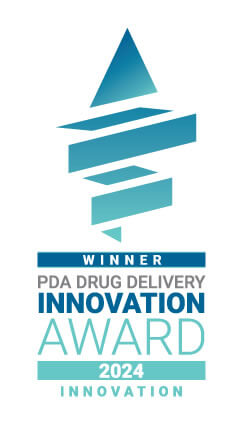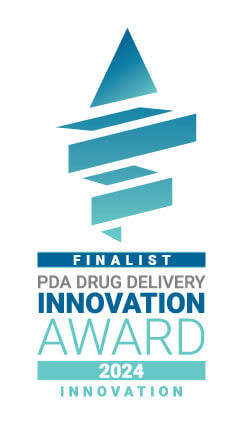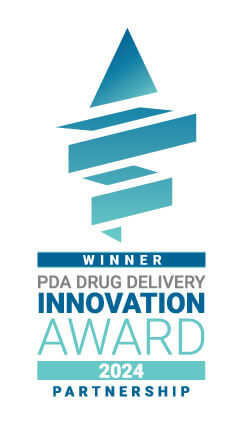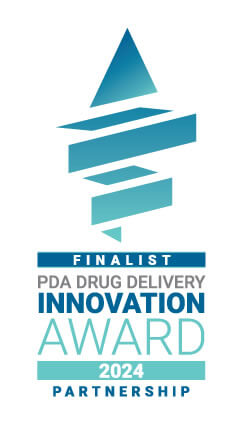
Innovation Awards
Congratulations to the 2024 Innovation Award Winners!
Innovation is about finding creative solutions to overcome challenges. Whether you develop cutting-edge tools, inspire others, or pave new paths, you are shaping a better future. The PDA Innovation Awards celebrate our community’s forward-thinking innovators.
Innovation Award Winners
3D Imaging and Analysis of Large Volume (20ml) Viscous (25cp) Injections with Fast Delivery Rates (10ml/Min) in a Porcine Model: Risks and Opportunities
3D Imaging and Analysis of Large Volume (20ml) Viscous (25cp) Injections with Fast Delivery Rates (10ml/Min) in a Porcine Model: Risks and Opportunities
Joel Gresham and Simon Dell’s innovation, 3D Imaging and Analysis of Large Volume (20mL) Viscous (25cP) Injections with Fast Delivery Rates (10mL/min) in a Porcine Model: Risks and Opportunities, is the result of a systematic experimental study of injection performance for high dose (large volume, high viscosity) injectables. They quantified the effects of volume, viscosity, and rate on injection performance, relevant to devices, formulations, and human factors.
Joel and Simon were inspired to innovate because, during the evaluation of large-volume injection devices for a range of new drug products, they encountered a common challenge. Most device manufacturers had very limited knowledge on how large and fast the safe volumes and injection rates could be. There was no evidence to support the safety and practicality of large-volume injectables for patients.
Their innovation helps the industry by setting a benchmark for the safe and practical design of large-volume injectables. Their data provide valuable insights into required user forces, device specifications, drug-tissue interactions, and bleb/wheal formation. Joel and Simon also evaluated the most critical device and formulation design parameters that influence these performance metrics.
Innovation Award Finalists
Development of a Small Molecule, High Viscosity, High PH Injectable for HIV Treatment
Development of a Small Molecule, High Viscosity, High PH Injectable for HIV Treatment
Sunleca, the Small Molecule, High Viscosity, High pH Injectable for HIV Treatment is a bi-annual injection for the treatment of people living with HIV who have developed resistance to multiple HIV treatments. Scott and Alasdair were inspired by one of Gilead’s ambitions to end the HIV epidemic for everyone, everywhere. The injectable is an additional tool that can help people living with HIV to live full and healthy lives.
Sunleca’s unique properties will continue to test the limits of what can be done to design and develop effective drug delivery solutions. The advancements made to support its requirements will benefit the industry as more and more unique formulations require drug delivery systems.
Novel Polymer Pre-Filled Syringes for Intravitreal Injections: Challenges and Key Learnings
Novel Polymer Pre-Filled Syringes for Intravitreal Injections: Challenges and Key Learnings
Ocular diseases are a major area of global unmet healthcare needs with a significant impact on patients’ lives, with diseases such as Age-related Macular Degeneration (AMD). Intravitreal injection is an established route of administration to treat diseases such as AMD. However, intravitreal (IVT) injection requires special considerations for administration, primary packaging and formulation. Intravitreal injections are typically supplied in a 0.5 mL, or sometimes 1 mL, prefilled-syringe (PFS) configurations, and in most cases with a luer-lock closure with specific focus on particulate matter, endotoxins and final product sterility. IVT drugs are low dosage drugs which correspond to low fill volume in the syringes and specific techniques like bubble free filling and stopper setting in fill and finish operations. Therefore, it is of utmost importance to holistically develop product solutions for intravitreal use by appropriately developing and selecting the formulation, availability and characterization of an adequate primary packaging for manufacturing. The collaboration with Terumo and ten23 health for the PLAJEX™ syringe option is one great example of such an approach.
They were inspired do this work because of a growing prevalence of ocular diseases and the need to offer safer treatment options. Injection of particulates into the vitreous body, including silicone oil droplets, have been specifically linked with floaters (spots that impair vision). Collaboration across industry stakeholders will enable the treatment of more patients and ability to treat them better.
The integrated work of Terumo and ten23 health is accessible for collaborations with pharma and biotech customers. In addition, it provides a good example of the importance of collaboration across the value chain, helping pharma customers bring their products to the market faster and enhance patient safety and treatment efficacy.
Quantification of User Inputs During Injection Device Use: An Anthropometric Human Factors Study
Quantification of User Inputs During Injection Device Use: An Anthropometric Human Factors Study
Her innovation, Quantification of User Inputs During Injection Device Use: An Anthropometric Human Factors Study proposes a new approach to quantify user behavior during injection devices. She uses two case studies, one for an autoinjector and the other for a safety syringe device, to identify how data can be used and applied to drug-device combination (DDC) product development. By embedding sensors into injection device replicas, it’s possible to measure forces applied during the injection process and the angle at which each device was held during the administration, in a real-life setting. The work supports the combination of objective data and qualitative user data to better inform device selection and device requirements to maximize user acceptance.
Enrica was inspired by her interest in combining objective evidence with patients’ feedback to find optimal solutions to meet user needs. She says that technology can enhance our understanding of human behavior and better inform current clinical practice and treatment provision. She was inspired to better understand injection device use and move outside of a laboratory setting to better inform current practice -- with the patient always front and center. She spent several years doing research, pre- and post-doc, where she would quantify human motion through 3D motion capture systems, and force platforms to better understand disease progression and/or quantify the impact of treatments in a laboratory setting. She took this a step further and used wearable technologies that she developed (smart knee sensor) or off the shelf (inertia measurement unit, force insoles) to capture the same data she would measure with laboratory technologies in real-life settings. The goal was to propose solutions to mitigate the development of disorders, identify objective markers of disease detection/progression, and increase patients’ satisfaction and adherence.
Enrica says most industries rely on published anthropometric data to establish the appropriateness of devices yet are limited by data that are not relatable to actual device use. Also, the industry has relied on qualitative feedback of subjective and/or pass/failure use tests requiring lots of repetitions to establish specification limits. Her approach provides a framework to capture data over device use to fully quantify the behavior. This establishes design criteria more accurately, better meets users’ expectations and needs, and therefore ensures that users maintain adherence to their treatment. The data acquired are also useful at the early stage of product development as well as at the late stage when regulatory agencies require evidence of the appropriateness of design input requirements. Her innovation also validates recently redefined Essential Drug Delivery Outputs (EDDO).
Partnership Award Winners
Reusability Simplified: The Journey to Develop a Sustainable, Low-Cost Reusable Autoinjector
Reusability Simplified: The Journey to Develop a Sustainable, Low-Cost Reusable Autoinjector
The AstraZeneca Reusable Autoinjector platform is designed to meet a key industry challenge – creating a reusable parenteral drug delivery device that is both low cost and sustainable, while offering exceptional usability and safety. The device, developed by AstraZeneca with support from Team Consulting, features a fully mechanical reusable mechanism that is paired with a low-cost single use cassette, removing the need for carbon-costly electronic components typically found in other reusable systems. With a highly optimized user-centred design and intuitive use steps, it is set to offer a novel approach to the reusable autoinjector market.
Duncan and Michael were inspired for this project by a perceived gap in the reusable autoinjector landscape for a simple, low-cost and sustainable device to meet the needs of products intended for highly competitive or low-income markets, and to minimize environmental impact. The AstraZeneca Reusable Autoinjector has been designed as an alternative to single use autoinjectors, that meets these needs while not compromising on usability or safety. Current state-of-the-art single use autoinjectors require users to perform only two simple steps to administer a dose. In contrast, reusable systems introduce additional and potentially more complex steps associated with loading the single-use drug container prior to use, then removing it after use. Reusable autoinjectors tend to include complex electromechanical drive systems, electronics and/or connectivity to help achieve acceptable levels of usability, but these features come with significant cost and environmental impacts. The AstraZeneca Reusable Autoinjector is a fully mechanical product and negates the need for high cost and high carbon footprint components such as batteries, PCBs, motors and other complex electronic components, as well as additional systems such as charging stations. This also substantially decreases the financial implications of onboarding and equipping new patients, as well as early termination of treatment or loss/damage to the reusable portion of the device.
Partnership Award Finalists
Next-Generation Pre-Filled Syringe Soft Mist Inhaler: Exploring Potential and Benefits for Delivering Sensitive Biologics and mRNA Vaccines via the Intranasal Route
Next-Generation Pre-Filled Syringe Soft Mist Inhaler: Exploring Potential and Benefits for Delivering Sensitive Biologics and mRNA Vaccines via the Intranasal Route
Their innovation, the PFS Soft-Nasal-Spray is a sterile, single-use, disposable, prefilled glass syringe with bespoke syringe closure containing a nanotech spray nozzle technology and a valve for container closure integrity. With the integrated Alba® platform and its cross-linked coating technology the Soft Nasal Spray reduces the interactions between drug products and the CCS, thereby providing a superior packaging solution for sensitive ingredients, even at deep cold storage conditions down to -60oC. The nanotech spray technology improves the drug delivery efficiency to the posterior part and the olfactory region of the nasal cavity thus improving the delivery of nasal vaccines and central nervous system via the nose-to-brain barrier.
They were inspired to create the innovation in response to the global market for inhalation drug delivery devices that is growing rapidly. This market is expected to reach a value of $20.7bn by 2031, growing at a CAGR of 4.4% over the forecast period. Specifically, the nasal vaccine segment is expected to reach $742.6m by 2030, up from $416.8m in 2023.
The nasal route holds potential for the systemic delivery of a range of protein and peptide drugs thanks to its large absorption area (150cm2), which is highly vascularized with a similar permeability to the small intestinal mucosa. Nasal delivery also offers other benefits, such as ease of administration, non-invasive administration, rapid onset of action, as well as the avoidance of gastrointestinal degradation and hepatic first-pass effects. Furthermore, intranasal delivery is significantly more straightforward for patients to administer themselves, compared with the parenteral approach.
Their Nasal Spray will help the industry as it addresses an issue for all biological treatments; the area of the nasal cavity that needs to be dosed, as well as the dose volume, are critical for drug efficacy. Selective drug administration to the olfactory region for effective nose-to-brain delivery of biologics, oxytocin, polypeptides, and other short interfering RNAs will benefit from the use of the PFS Soft-Nasal-Spray. Intranasal vaccination strategies will also benefit from a larger and more uniform formulation coverage of the mucosal tissue as it can be achieved with the PFS Soft-Nasal-Spray.
In both cases, drug product developers will benefit from a highly efficient and complete delivery of the drug product to the nose which is highly desired due to the high cost and low potency of many novel biological compounds. As more and more biological products reach the end of their patents, demand for solutions to extend their life cycles will also increase. PFS Soft-Nasal-Spray can give drug developers blockbuster biologic formulations a new lease of life, while also allowing them to potentially improve therapeutic outcomes and better meet patients’ convenience needs.
The Journey of Pioneering a MRNA Vaccine in a Pre-Filled Syringe

















